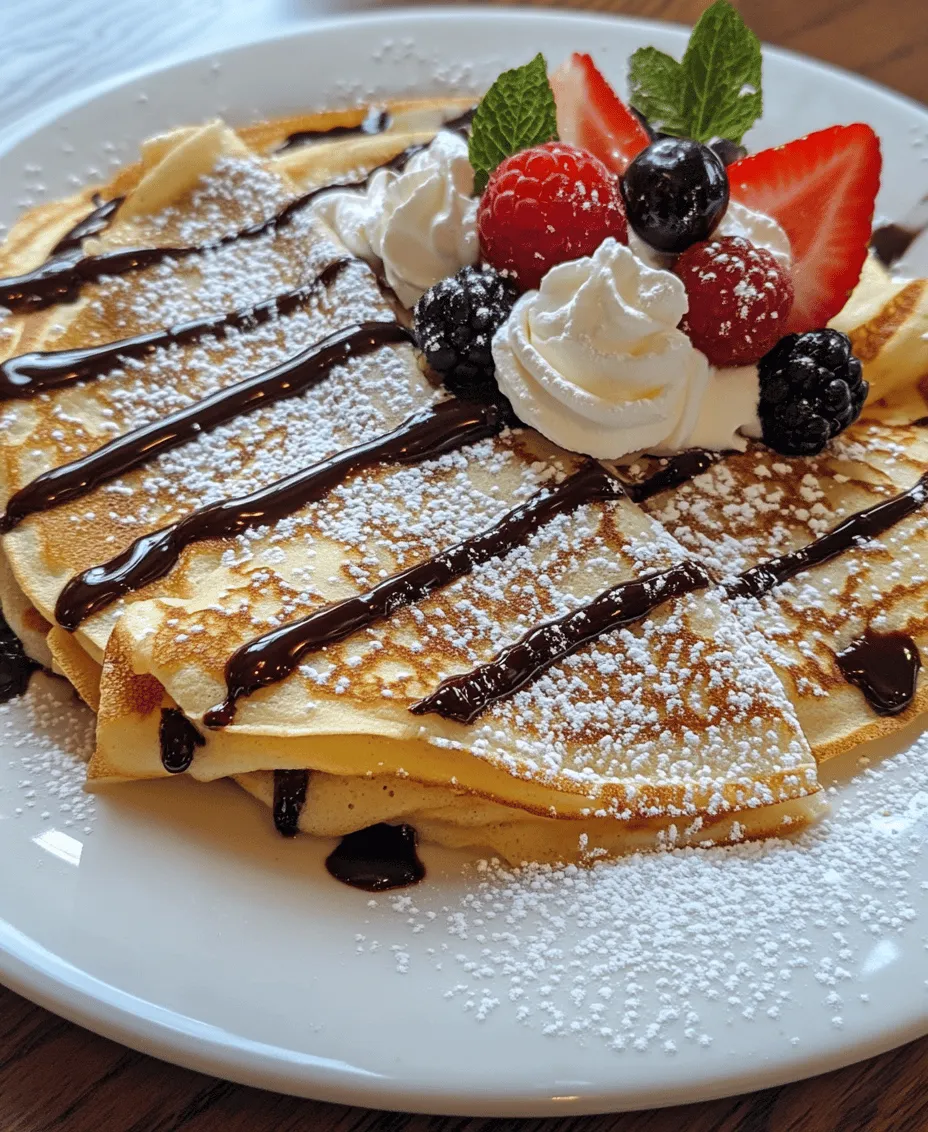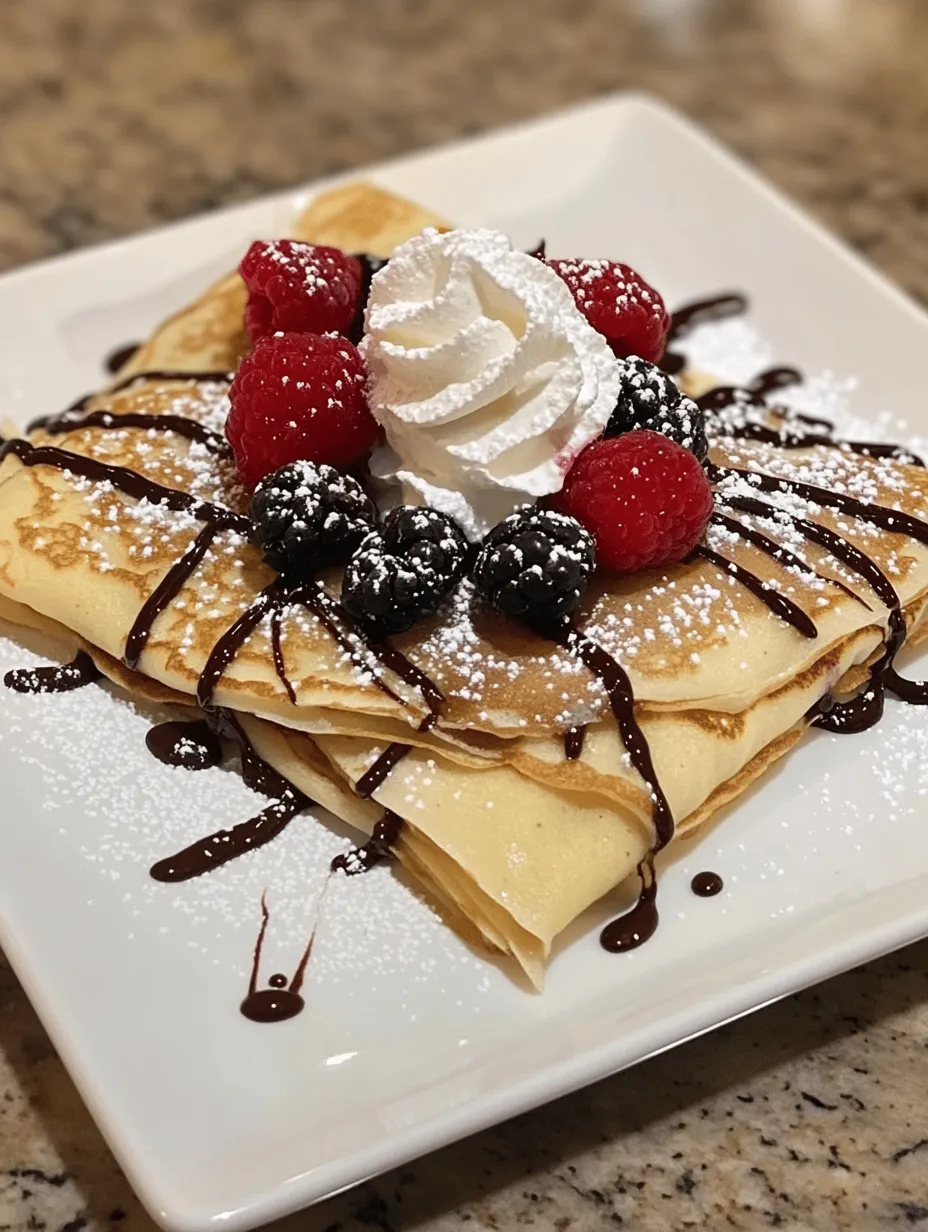Introduction
Crepes are a beloved dish around the globe, known for their light, thin texture and incredible versatility. Originating from France, these delicate pancakes can be enjoyed sweet or savory, making them a popular choice for breakfast, lunch, dinner, and even dessert. The beauty of crepes lies in their adaptability; they can be filled or topped with a plethora of ingredients, from fresh fruits and whipped cream to savory cheeses and vegetables. In this article, we will focus on a delightful variant—Delicate Vanilla Crepes. This recipe not only highlights the simplicity of making crepes but also emphasizes their deliciousness, making them perfect for any occasion.
Whether you’re hosting a brunch, planning a romantic dinner, or simply looking for a sweet treat, these vanilla crepes will impress your family and friends. With just a handful of ingredients and straightforward steps, you’ll find that whipping up these crepes is a rewarding culinary adventure.
Understanding the Basics of Crepes
Before diving into the recipe, let’s explore what crepes are and how they fit into the culinary landscape. Crepes are thin pancakes made from a simple batter of flour, eggs, milk, and butter. They are cooked on a flat surface or skillet, resulting in a delicate texture that distinguishes them from thicker pancakes.
Origins and Differences
Crepes have a rich history that dates back to the 13th century in Brittany, France. They were initially made with buckwheat flour, particularly in savory varieties known as “galettes.” Over time, crepes evolved, and variations emerged across different regions, including the popular sweet versions made with all-purpose flour.
One of the main distinctions between crepes and pancakes lies in their texture and thickness. Crepes are much thinner than traditional pancakes, which are fluffier due to the leavening agents like baking powder. This thinner consistency allows crepes to be more versatile, as they can easily wrap around fillings or be folded elegantly.
Cultural Significance
Crepes hold a special place in various cultures. In France, they are often served with a drizzle of syrup or a dusting of sugar, and are commonly enjoyed during the annual holiday of Candlemas, where it’s said that flipping a crepe with one hand while holding a coin in the other will bring prosperity for the year. In Japan, crepes have taken on a unique twist, often filled with sweet ingredients and rolled up for easy eating on the go. The global love for crepes speaks to their ability to adapt and satisfy diverse palates.
Ingredients Breakdown
To create the perfect Delicate Vanilla Crepes, you’ll need to gather some essential ingredients. Each component plays a vital role in achieving that desired texture and flavor.
All-Purpose Flour
All-purpose flour is the foundation of the crepe batter, providing structure and a light texture. When mixed with the other ingredients, it helps to create a smooth, pliable batter that can easily spread across the pan. It’s important to choose high-quality flour to ensure the best results.
Eggs
Eggs are crucial in the crepe-making process. They serve as a binding agent, helping to hold the batter together while also adding richness. The proteins in the eggs contribute to the crepes’ structure, ensuring they don’t fall apart during cooking.
Milk
Milk is another essential ingredient that impacts the consistency of the batter. It adds moisture, helping to create a thin, pourable mixture. The type of milk can be adjusted based on dietary preferences; whole milk will yield richer crepes, while low-fat or non-dairy alternatives can also work well.
Sugar
Sugar is added to the batter to provide a subtle sweetness that complements the vanilla flavor. It enhances the overall taste profile of the crepes, making them enjoyable even when served plain. The amount of sugar can be adjusted depending on personal preference or the type of toppings used.
Vanilla Extract
Vanilla extract is the star of this recipe, giving the crepes their signature flavor. It adds warmth and depth, elevating the taste to a whole new level. For the best flavor, opt for pure vanilla extract rather than imitation vanilla.
Salt
While it may seem counterintuitive to add salt to a sweet dish, a pinch of salt is essential for balancing flavors. It enhances the sweetness and helps to bring out the vanilla notes, making the crepes taste more rounded and satisfying.
Butter
Butter plays a dual role in this recipe. First, it adds richness and flavor to the crepe batter. Second, a small amount is used for greasing the pan, ensuring the crepes cook evenly and don’t stick. Using clarified butter can also enhance the flavor while providing a higher smoke point.
Optional Toppings
The beauty of crepes lies in their versatility, and you can customize them with a variety of toppings. Fresh fruits like strawberries, bananas, or blueberries pair beautifully with whipped cream or yogurt. For a more decadent treat, consider adding chocolate sauce, caramel, or a sprinkle of powdered sugar. Savory options can include cheese, ham, or sautéed vegetables, making crepes suitable for a wide range of tastes.
Step-by-Step Instructions for Making Delicate Vanilla Crepes
Now that we’ve covered the ingredients, let’s get into the step-by-step process of making Delicate Vanilla Crepes. Following these instructions will ensure that you achieve the perfect crepe every time.
Proper Mixing Techniques
The key to creating a smooth batter lies in how you mix the ingredients. Start by whisking the dry ingredients together—this includes the all-purpose flour, sugar, and salt. Combining these first helps to ensure that the sugar and salt are evenly distributed throughout the flour.
Next, in a separate bowl, whisk together the eggs and milk. This step is crucial as it allows the eggs to incorporate fully with the liquid before combining with the dry mixture. Gradually pour the wet mixture into the dry ingredients, stirring continuously to avoid lumps. The goal is to achieve a smooth batter without any flour clumps.
Achieving a Smooth Batter Consistency
Once the ingredients are combined, you should have a thin, pourable batter. If it seems too thick, feel free to add a little more milk until you reach the desired consistency. A properly mixed batter should be fluid enough to easily spread in a pan, but not so runny that it loses its structure.
The Significance of Resting the Batter
One crucial step that many novice cooks overlook is resting the batter. Allowing the batter to sit for at least 30 minutes (or up to 2 hours) in the refrigerator will improve the texture of the crepes. During this resting period, the flour hydrates fully, and the gluten relaxes, resulting in a more elastic batter. This means your crepes will be less likely to tear while cooking and will have a tender bite once cooked.
By following these initial steps, you’ll set yourself up for success in making Delicate Vanilla Crepes. The process may seem simple, but the results will impress both your taste buds and your guests. In the next part of this article, we will delve into the cooking techniques and additional tips to ensure your crepes turn out perfectly every time.

Cooking Techniques for Perfect Crepes
Creating delicate vanilla crepes is an art that combines precise techniques and a bit of practice. To achieve the perfect crepe, mastering heat management and pan preparation is crucial.
Tips on Heat Management and Pan Preparation
1. Choose the Right Pan: A non-stick skillet or crepe pan is ideal for making crepes. The smooth surface allows for easy flipping and prevents sticking.
2. Preheat Your Pan: Before pouring in the batter, preheat your skillet over medium heat. A well-heated pan helps the crepes cook evenly. You can test if the pan is ready by sprinkling a few drops of water on its surface; if they dance and evaporate quickly, the pan is hot enough.
3. Adjust the Heat: If your crepes are cooking too quickly or browning too much, lower the heat slightly. Conversely, if they’re taking too long to cook, increase the heat. Finding the right balance is key to ensuring your crepes are tender and golden without burning.
4. Use a Little Fat: Lightly grease the pan with butter or oil before each crepe. This not only adds flavor but also helps in releasing the crepes easily. Use a paper towel to spread a thin layer of fat, ensuring not to drown the pan.
The Art of Flipping Crepes Without Tearing
Flipping crepes can be daunting, but with practice, you’ll master this skill:
1. Cook Until the Edges Lift: Once the crepe has cooked for about 1-2 minutes, the edges will start to lift slightly from the pan. This indicates that it’s ready to flip.
2. Loosen the Crepe: Use a silicone spatula to gently lift the edges of the crepe. Work your way around the perimeter to ensure it’s loose from the pan.
3. Use a Quick Motion: With a confident flick of the wrist, flip the crepe over. If you’re feeling adventurous, you can try flipping it in the air, but this may take some practice!
4. Cook the Other Side: Allow the crepe to cook for another 30 seconds to a minute until it’s lightly golden. Remember, the second side cooks faster than the first.
Exploring Toppings and Variations
One of the joys of making vanilla crepes is the endless possibilities for toppings. Whether you prefer sweet or savory, there’s something for everyone.
Suggestions for Classic and Creative Toppings
1. Fresh Fruits: Seasonal fruits like strawberries, blueberries, raspberries, and bananas make for vibrant and healthy toppings. These fruits not only add flavor but also a range of vitamins and antioxidants. For instance, strawberries are rich in vitamin C, while bananas provide potassium.
2. Whipped Cream: Light and fluffy whipped cream enhances the sweetness of crepes. You can choose to make homemade whipped cream using heavy cream and sugar, or use store-bought varieties for convenience. If you opt for homemade, consider adding a splash of vanilla extract for an extra flavor boost.
3. Chocolate Sauce: Elevate your crepes with chocolate sauce. Dark chocolate pairs beautifully with the vanilla flavor of the crepes, while milk chocolate offers a sweeter touch. White chocolate can add a creamy contrast, especially when combined with fruits. Drizzle your choice of chocolate sauce over the crepes for an indulgent treat.
4. Powdered Sugar: A dusting of powdered sugar is a simple yet elegant way to present your crepes. It adds a touch of sweetness without overwhelming the palate, making it perfect for brunch or dessert.
Ideas for Savory Variations
If you’re looking to switch things up, consider these savory crepe fillings:
1. Cheese: A blend of cheeses such as ricotta, feta, or even mozzarella can create a rich filling. Pair with fresh herbs for added flavor.
2. Spinach: Sautéed spinach mixed with cheese can create a delightful savory option. Adding garlic and a pinch of nutmeg enhances the taste.
3. Mushrooms: Sautéed mushrooms with herbs can make for a hearty and delicious filling. Combine with cream for a luxurious touch.
Serving Suggestions and Pairing Ideas
When it comes to serving your delicate vanilla crepes, presentation is key. Here are some best practices and complementary suggestions.
Best Practices for Serving Crepes Warm
Crepes are best enjoyed fresh and warm. Serve them immediately after cooking for the best texture. Stack them on a plate and cover them with a clean kitchen towel to keep them warm while you finish cooking the rest.
Suggestions for Complementary Side Dishes and Beverages
1. Beverages: Pair your crepes with a cup of freshly brewed coffee, a fragrant herbal tea, or a refreshing glass of fruit juice. A citrus-based juice can provide a nice contrast to the sweetness of the crepes.
2. Side Dishes: Consider serving your crepes alongside light salads or yogurt parfaits. A simple arugula salad dressed with lemon vinaigrette can balance the richness of the crepes.
Presentation Ideas for Special Occasions
For special events or breakfast gatherings, you can elevate your crepe presentation:
– Arrange crepes neatly on a large platter and drizzle with sauces.
– Garnish with fresh mint leaves or edible flowers for a visual pop.
– Serve with a selection of toppings in small bowls, allowing guests to customize their crepes.
Nutritional Value and Health Aspects
Understanding the nutritional content of delicate vanilla crepes can help you make informed choices.
Overview of Nutritional Content in Vanilla Crepes
A standard serving of vanilla crepes typically contains around 90-110 calories, depending on the ingredients used. The macronutrient breakdown includes approximately:
– Carbohydrates: 15-20 grams
– Protein: 2-3 grams
– Fat: 3-5 grams
This can vary based on the type of flour and the fillings you choose.
Discussion on Making Healthier Substitutions
For those looking to enjoy crepes with a healthier twist, consider these alternatives:
1. Alternative Flours: Swap all-purpose flour for whole wheat or oat flour to increase fiber content. Almond flour can also be a gluten-free option.
2. Dairy-Free Options: Use almond milk, oat milk, or coconut milk instead of regular milk for a dairy-free version. These alternatives can add unique flavors to your crepes.
3. Sugar Substitutes: If you’re looking to reduce sugar intake, consider using natural sweeteners such as maple syrup or honey, or even a sugar substitute like stevia.
Conclusion
Delicate vanilla crepes are not just a delightful culinary experience; they are a versatile dish that can be enjoyed in countless ways. From sweet to savory, the options for toppings and fillings are endless, making them perfect for brunch, dessert, or even a light dinner.
As you experiment with different flavors, don’t hesitate to get creative with your toppings. Whether you’re preparing them for a special occasion or a casual breakfast, the joy of making and sharing crepes will bring warmth and satisfaction to your table.
Crepes have a timeless nature that transcends culinary traditions around the globe, inviting you to explore and enjoy their versatility. So gather your ingredients, perfect your technique, and dive into the wonderful world of delicate vanilla crepes.



